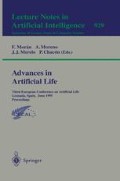Abstract
The paper distinguishes between two different modes of learning by neural networks. Traditional networks learn in the passive mode by incorporating in their internal structure the regularities present in the input and teaching input they passively receive from outside. Networks that live in a physical environment (ecological networks) can learn in the active mode by acting on the environment and learning to predict what changes in the environment or in their relation to the environment are caused by their actions. Being able to predict the consequences of one's own actions is useful when one wants to cause desired consequences with these actions. The paper contrasts learning to predict the consequences of one's actions with learning to predict environmental changes that are independent from the network's actions. It then discusses how perceptually ‘hidden’ properties of the environment such as the weight of objects are better learned in the active rather than in the passive mode and how learning in the active mode can be particularly useful in a social environment and in learning by imitating others. Learning in the active mode appears to be a crucial component of the human adaptive pattern and is tightly linked to another component of this pattern, i.e., the human tendency to modify the external environment rather than adapt to the environment as it is.
Preview
Unable to display preview. Download preview PDF.
References
Cecconi, F., Menczer, F. and Belew, R.K. Learning and the evolution of age at maturity. Submitted to Adaptive Behavior, 1994.
Cecconi, F. and Parisi, D. Evolving organisms that can reach for objects. In J-A. Meyer and S.W. Wilson (eds.) From Animals to Animats. Cambridge, Mass., MIT Press, 1991.
Cecconi, F. and Parisi, D. Learning during reproductive immaturity in evolving populations of neural networks. Submitted to Journal of Theoretical Biology. 1994.
Denaro, D. and Parisi, D. Imitation and cultural transmission in populations of neural networks. Institute of Psychology, CNR, Rome, 1994.
Elman, J.L. Finding structure in time. Cognitive Science, 1990, 14, 179–211.
Elman, J.L. Distributed representations, simple recurrent networks, and grammatical structure. Machine Learning, 1991a, 7, 195–225.
Elman, J.L. Incremental learning, or The importance of starting small. In Proceedings of the 13th Annula Conference of the Cognitive Science Society. Hillsdale, N.J., Erlbaum, 1991b.
Floreano, D. and Parisi, D. A connectionist account of language development: imitation and naming. Institute of Psychology, CNR, Rome, 1994.
Goldman, A.I. Interpretation psychologized. Mind and Language, 1989, 4, 161–185.
Gordon, R.M. Folk psychology as simulation. Mind and Language, 1986, 1, 158–171.
Gordon, R.M. The simulation theory: objections and misconceptions. Mind and Language, 1992, 7, 11–34.
Hutchins, E. and Hazelhurst, B. How to invent a lexicon: the development of shared synbols in interaction. In N. Gilbert and R. Conte (eds.) Artificial Societies: the Computer Simulation of Social Life. London, UCL, in press.
Jordan, M.I. and Rumelhart, D.E. Forward models: supervised learning with a distal teacher. Cognitive Science, 1992, 16, 307–354.
McClelland, J.L. Parallel distributed processing: implications for cognition and development. In R.G.M. Morris (ed.) Parallel Distributed Processing: Implications for Psychology and Neurobiology. Oxford, Clarendon Press, 1989.
Nolfi, S., Elman, J.L. and Parisi, D. Learning and evolution in neural networks. Adaptive Behavior, 1994, 3, 5–28.
Nolfi, S. and Parisi, D. Self-selection of stimuli for improving performance. In G.A. Bekey (ed.) Neural Networks and Robotics. New York, Kluwer Academics, 1993.
Parisi, D. An Artificial Life approach to language. Submitted to Brain and Language, 1995.
Parisi, D., Cecconi, F. and Nolfi, F. Econets: neural networks that learn in an environment. Network, 1990, 1, 149–168.
Parisi, D., Nolfi, S. and Cecconi, F. Learning, behavior, and evolution. In F.J. Varela and P. Bourgine (eds.) Toward a Practice of Autonomous Systems. Camrbidge, Mass., MIT Press, 1992.
Rumelhart, D.E. Toward a microstructural account of huamn reasoning. In S. Vosniadou and A. Ortony (eds.) Similarity and Analogical Reasoning. Cambridge, Cambridge University Press, 1989.
Stearns, S.C. The Evolution of Life Histories. New York, Oxford University Press, 1992.
van der Meer, A.L.H., van der Weel, F.R., and Lee, D.N. The functional significance of arm movements in neonates. Science, 1995, 267, 693–695.
Visalberghi, E. and Fragaszy, D. Do monkeys ape? In S. Parker and K. Gibson (eds.) “Language” and intelligence in monkeys and apes. Cambridge, Cambridge University Press, 1990.
Weigand, S.A., Rumelhart, D.E. and Huberman, B.A. Generalization by weight-elimination with application to forecasting. In R.P. Lippman, J.E. Moody, and D.S. Touretsky (eds.) Advances in Neural System Processing 3, San Mateo, Cal., Morgan Kaufmann, 1991.
Wellman, H.M. The Child's Theory of Mind. Cambridge, Mass., MIT Press, 1990.
Author information
Authors and Affiliations
Editor information
Rights and permissions
Copyright information
© 1995 Springer-Verlag Berlin Heidelberg
About this paper
Cite this paper
Parisi, D., Cecconi, F. (1995). Learning in the active mode. In: Morán, F., Moreno, A., Merelo, J.J., Chacón, P. (eds) Advances in Artificial Life. ECAL 1995. Lecture Notes in Computer Science, vol 929. Springer, Berlin, Heidelberg. https://doi.org/10.1007/3-540-59496-5_317
Download citation
DOI: https://doi.org/10.1007/3-540-59496-5_317
Published:
Publisher Name: Springer, Berlin, Heidelberg
Print ISBN: 978-3-540-59496-3
Online ISBN: 978-3-540-49286-3
eBook Packages: Springer Book Archive

